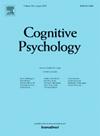Processing spatial cue conflict in navigation: Distance estimation
IF 3
2区 心理学
Q1 PSYCHOLOGY
引用次数: 0
Abstract
Spatial navigation involves the use of various cues. This study examined how cue conflict influences navigation by contrasting landmarks and optic flow. Participants estimated spatial distances under different levels of cue conflict: minimal conflict, large conflict, and large conflict with explicit awareness of landmark instability. Whereas increased cue conflict alone had little behavioral impact, adding explicit awareness reduced reliance on landmarks and impaired the precision of spatial localization based on them. To understand the underlying mechanisms, we tested two cognitive models: a Bayesian causal inference (BCI) model and a non-Bayesian sensory disparity model. The BCI model provided a better fit to the data, revealing two independent mechanisms for reduced landmark reliance: increased sensory noise for unstable landmarks and lower weighting of unstable landmarks when landmarks and optic flow were judged to originate from different causes. Surprisingly, increased cue conflict did not decrease the prior belief in a common cause, even when explicit awareness of landmark instability was imposed. Additionally, cue weighting in the same-cause judgment was determined by bottom-up sensory reliability, while in the different-cause judgment, it correlated with participants’ subjective evaluation of cue quality, suggesting a top-down metacognitive influence. The BCI model further identified key factors contributing to suboptimal cue combination in minimal cue conflicts, including the prior belief in a common cause and prior knowledge of the target location. Together, these findings provide critical insights into how navigators resolve conflicting spatial cues and highlight the utility of the BCI model in dissecting cue interaction mechanisms in navigation.
导航空间线索冲突的处理:距离估计
空间导航涉及到各种线索的使用。本研究通过对比地标和光流来研究线索冲突如何影响导航。参与者在不同提示冲突水平下估计空间距离:最小冲突、大冲突和具有地标不稳定性外显意识的大冲突。单独增加线索冲突对行为影响不大,而增加显性意识会减少对地标的依赖,并损害基于地标的空间定位精度。为了了解潜在的机制,我们测试了两种认知模型:贝叶斯因果推理(BCI)模型和非贝叶斯感觉差异模型。BCI模型提供了更好的拟合数据,揭示了降低地标依赖的两个独立机制:当判断地标和光流来自不同原因时,不稳定地标的感觉噪声增加,不稳定地标的权重降低。令人惊讶的是,线索冲突的增加并没有减少对共同原因的先验信念,即使在明确意识到里程碑不稳定性的情况下也是如此。在同因判断中,线索权重由自下而上的感觉信度决定,而在异因判断中,线索权重与被试对线索质量的主观评价相关,提示受自上而下的元认知影响。BCI模型进一步确定了在最小提示冲突中导致次优提示组合的关键因素,包括对共同原因的先验信念和对目标位置的先验知识。总之,这些发现为导航者如何解决冲突的空间线索提供了重要的见解,并突出了脑机接口模型在剖析导航线索相互作用机制方面的实用性。
本文章由计算机程序翻译,如有差异,请以英文原文为准。
求助全文
约1分钟内获得全文
求助全文
来源期刊

Cognitive Psychology
医学-心理学
CiteScore
5.40
自引率
3.80%
发文量
29
审稿时长
50 days
期刊介绍:
Cognitive Psychology is concerned with advances in the study of attention, memory, language processing, perception, problem solving, and thinking. Cognitive Psychology specializes in extensive articles that have a major impact on cognitive theory and provide new theoretical advances.
Research Areas include:
• Artificial intelligence
• Developmental psychology
• Linguistics
• Neurophysiology
• Social psychology.
 求助内容:
求助内容: 应助结果提醒方式:
应助结果提醒方式:


